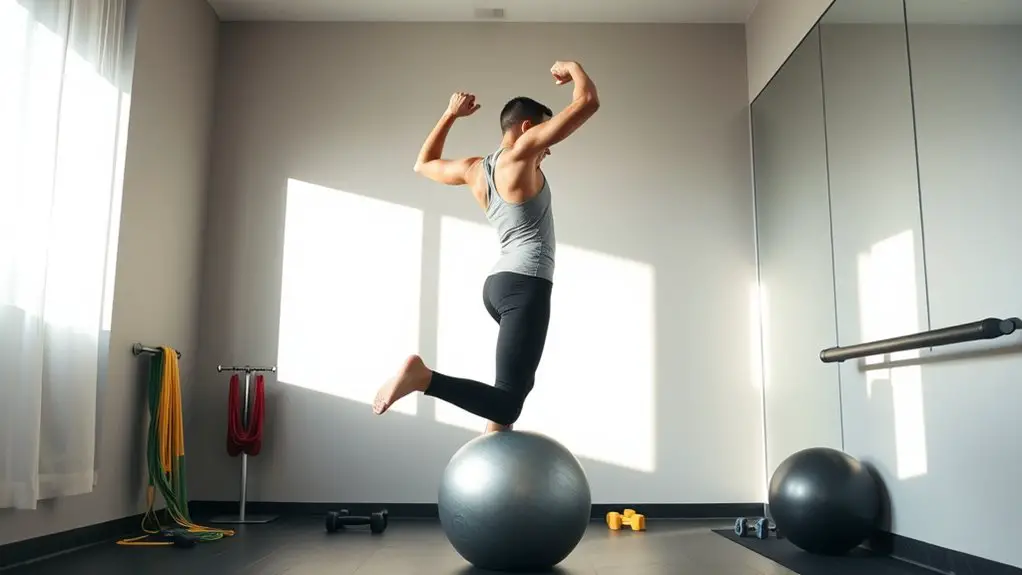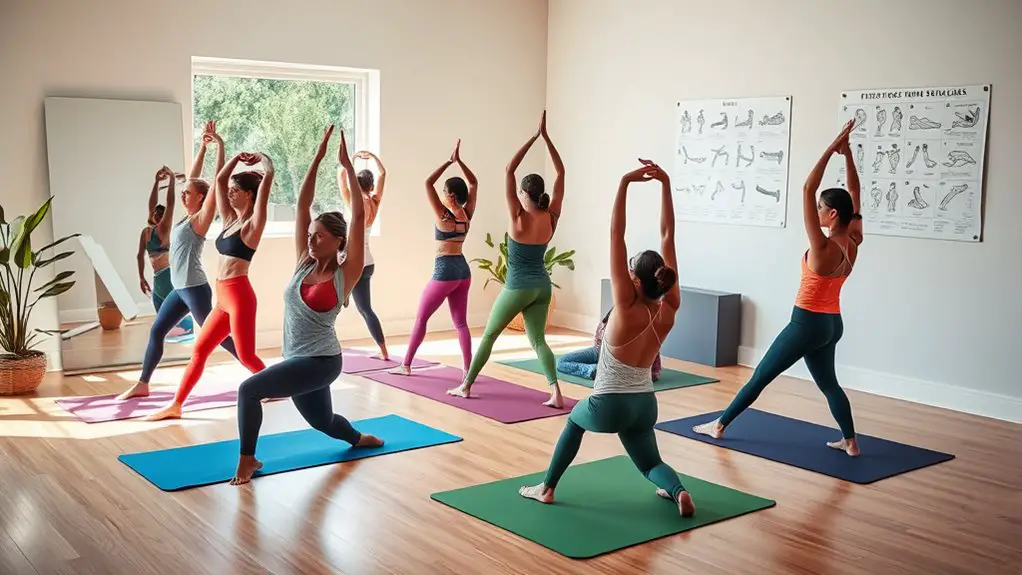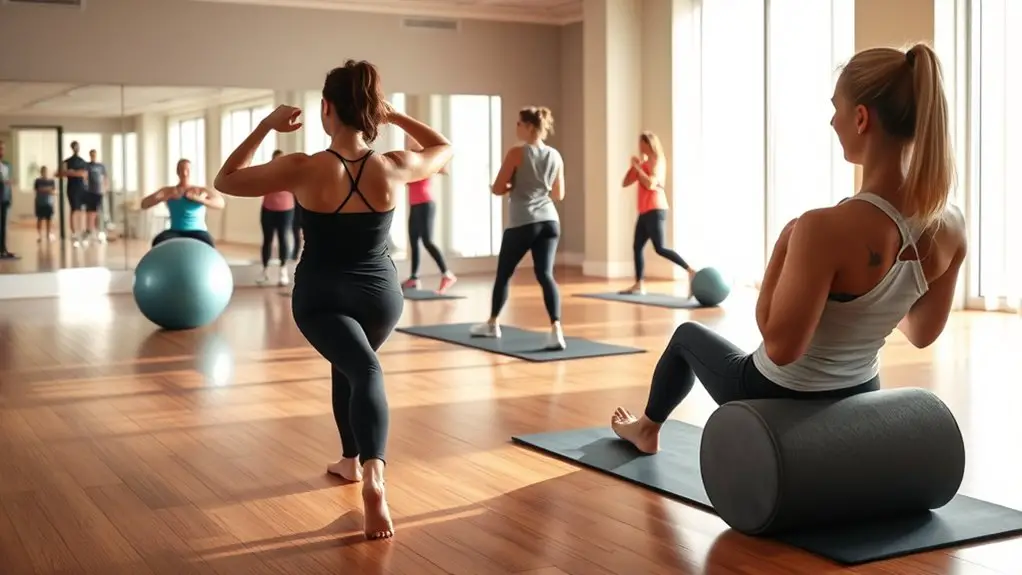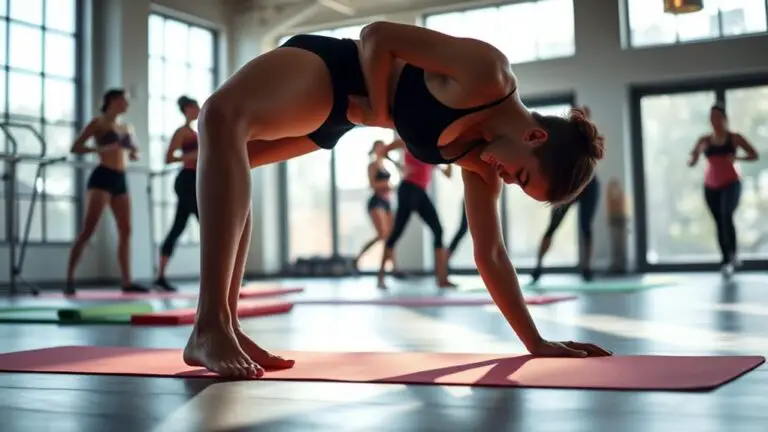The Best Gym Workouts for Individuals With Scoliosis

If you have scoliosis, it’s essential to focus on tailored workouts that prioritize core strength, flexibility, and safety. Start with warm-up exercises, then incorporate low-impact cardio like cycling or swimming. Strength training should include bodyweight exercises and resistance bands to enhance stability. Gentle stretching and yoga promote spinal flexibility. Always consult a healthcare professional for personalized advice and techniques. By understanding these key elements, you can enhance your fitness routine and improve your overall well-being.
Understanding Scoliosis and Its Impact on Fitness

Understanding scoliosis is fundamental for anyone looking to maintain an effective fitness routine, especially since this condition can greatly affect your posture and movement patterns. Scoliosis types vary, including idiopathic, congenital, and neuromuscular, each presenting unique challenges. Recognizing your specific type can help tailor your approach to fitness.
Incorporating pain management strategies is essential as well. Many individuals with scoliosis experience discomfort, particularly during physical activity. Techniques such as stretching, strengthening exercises, and proper warm-up routines can alleviate some of this pain. It’s important to listen to your body; if something feels wrong, don’t push through it.
Consulting with healthcare professionals, like physical therapists, can also provide you with personalized advice tailored to your condition. Ultimately, understanding scoliosis and its implications allows you to make informed decisions about your fitness journey while prioritizing your health and well-being.
Importance of a Tailored Workout Routine
Creating a tailored workout routine is essential for managing scoliosis effectively. An individualized assessment can help identify your specific needs, focusing on core strength, flexibility, and mobility. This personalized approach not only enhances your fitness but also supports overall spinal health.
Individualized Assessment Process
When it comes to managing scoliosis through exercise, an individualized assessment process is essential for developing an effective workout routine tailored to your specific needs. This process involves using various assessment methods to evaluate your posture, flexibility, and muscle strength. By understanding your unique spinal curvature and physical limitations, you can benefit from individualized training that focuses on your specific condition. This tailored approach not only enhances your workout efficacy but also minimizes the risk of injury. Working with a qualified trainer or physical therapist can provide valuable insights into your body mechanics, ensuring your routine is both safe and effective. Ultimately, an individualized assessment is key to achieving superior results while managing scoliosis.
Focus on Core Strength
A strong core is essential for anyone managing scoliosis, as it plays an important role in supporting the spine and maintaining proper posture. Focusing on core stability through targeted exercises can enhance your overall physical health. Here are key areas to evaluate for effective abdominal engagement:
- Planks: Build endurance in core muscles.
- Bird-Dogs: Improve balance and coordination while stabilizing the spine.
- Dead Bugs: Foster abdominal engagement without straining the back.
- Side Bridges: Strengthen obliques, promoting spinal alignment.
- Seated Rotations: Enhance flexibility and core strength.
Incorporating these exercises into your routine can lead to better postural control and reduced discomfort. Always consult a healthcare professional before starting any new workout regimen tailored to your specific needs.
Flexibility and Mobility Emphasis
To effectively manage scoliosis, focusing on flexibility and mobility is essential, as these elements can greatly improve your range of motion and overall quality of life. Incorporating tailored workout routines that include specific yoga poses can enhance spinal alignment and relieve tension in your back muscles. Poses like Child’s Pose and Cat-Cow are particularly beneficial in promoting flexibility. Additionally, foam rolling can play an important role in releasing tight muscles and improving circulation, which is critical for those with scoliosis. By integrating these activities into your routine, you’ll not only increase your mobility but also reduce discomfort, allowing you to engage more fully in your fitness journey. Always consult with a professional to guarantee your routine is safe and effective for your unique needs.
Warm-Up Exercises for Scoliosis
Warming up is essential for individuals with scoliosis, as it prepares your body for exercise while minimizing the risk of injury. Incorporating gentle stretching techniques and dynamic mobility drills can help improve flexibility and range of motion. By focusing on these warm-up exercises, you’ll set a solid foundation for your workout routine.
Importance of Warm-Up
While many people overlook the importance of a proper warm-up, it’s especially essential for individuals with scoliosis. Engaging in dynamic warm-ups can enhance your workout effectiveness and reduce injury risk. Here are key benefits of warming up:
- Increases blood flow to muscles and joints
- Improves flexibility and range of motion
- Prepares the nervous system for physical activity
- Reduces muscle stiffness and soreness
- Highlights the importance of hydration before exercise
Incorporating these practices into your routine can greatly enhance your physical performance. Remember, taking the time to warm up isn’t just a suggestion; it’s a critical step in managing your scoliosis effectively while ensuring a safe and productive workout. Prioritize these warm-up strategies to support your fitness journey.
Gentle Stretching Techniques
Incorporating gentle stretching techniques into your warm-up routine can greatly benefit individuals with scoliosis, as these exercises promote flexibility and help alleviate tension in the spine. Gentle yoga and foam rolling are excellent options to contemplate.
| Stretch Technique | Description |
|---|---|
| Gentle Yoga | Focus on poses like Child’s Pose and Cat-Cow to enhance spinal mobility. |
| Foam Rolling | Use a foam roller on the upper back and hips to release muscle tightness. |
| Side Stretches | Reach your arm overhead and lean to the opposite side to stretch the side body. |
These techniques can help you prepare your body for more intense workouts while ensuring that you maintain proper posture and reduce discomfort during your exercise sessions.
Dynamic Mobility Drills
Dynamic mobility drills serve as an essential component of your warm-up routine, especially for those with scoliosis. Incorporating dynamic stretching into your mobility routines can enhance flexibility and prepare your body for exercise. Here are some effective drills to contemplate:
- Arm Circles: Warm up your shoulders and increase range of motion.
- Leg Swings: Loosen up your hips and improve lower body mobility.
- Torso Twists: Gently engage your spine and enhance spinal mobility.
- Walking Lunges: Activate your legs and maintain balance while stretching.
- High Knees: Elevate your heart rate and improve coordination.
These drills can help you move more freely and reduce discomfort during workouts. Always listen to your body and consult a healthcare professional if you have concerns.
Strength Training Exercises
When it comes to managing scoliosis, strength training exercises can play a crucial role in enhancing spinal stability and overall muscle balance. Incorporating body weight exercises, like squats and modified push-ups, helps build foundational strength without excessive strain on your spine. You can also benefit from using resistance bands, which provide adjustable tension to target specific muscle groups effectively. For example, seated rows with resistance bands can strengthen your upper back, promoting better posture.
It’s important to perform these exercises with proper form to avoid injury, so consider working with a knowledgeable trainer who understands scoliosis. Start with lighter resistance and gradually increase as your strength improves. Consistent strength training not only supports your spine but also enhances your overall fitness, making daily activities easier and more enjoyable. Remember, focus on your body’s signals and adjust your routine as needed to guarantee safety and effectiveness.
Flexibility and Stretching Techniques

Flexibility and stretching techniques are essential components for individuals with scoliosis, as they help improve spinal mobility and reduce muscle tension. Incorporating these methods into your routine can enhance your overall comfort and function. Here are some effective strategies:
- Gentle yoga poses: Focus on poses like Child’s Pose and Cat-Cow to promote spinal flexibility.
- Foam rolling: Use a foam roller to release tight muscles, particularly in the back and hips.
- Seated forward bends: These stretches can lengthen your spine and hamstrings.
- Side stretches: Gently stretching each side can help maintain balance in muscle length.
- Breathing exercises: Incorporate deep breathing while stretching to enhance relaxation and engagement of core muscles.
Always consult with a healthcare professional before starting new exercises, and listen to your body. Consistent practice will yield the best results for managing scoliosis.
Cardiovascular Workouts Suitable for Scoliosis
Incorporating cardiovascular workouts into your routine can be highly beneficial for managing scoliosis, as they improve overall fitness and support spinal health. Low impact cardio options, like cycling or using an elliptical, are excellent choices since they minimize stress on your spine while still providing a strong cardiovascular workout.
One of the most effective forms of low impact cardio is swimming. The buoyancy of water supports your body, reducing strain on your spine and joints while allowing you to engage in a full range of motion. Swimming benefits include improved muscle strength and endurance, which can enhance postural control and overall stability.
Additionally, incorporating water aerobics can provide similar benefits, allowing you to work on cardiovascular fitness without the harsh impact on your back. Ultimately, choosing activities that are gentle yet effective will help in managing your scoliosis while enhancing your overall well-being.
Tips for Staying Safe While Working Out

To guarantee your safety while working out with scoliosis, it’s crucial to listen to your body and recognize its limits. Engaging in physical activity can be beneficial, but taking precautions guarantees you stay safe. Here are some essential tips:
- Use safe equipment: Verify weights and machines are appropriate for your level.
- Warm up properly: Spend at least 5-10 minutes warming up to prepare your muscles.
- Focus on form: Prioritize correct posture and technique to prevent injury.
- Stay hydrated: Drink plenty of water before, during, and after your workout to maintain proper hydration.
- Take breaks: Listen to your body and rest as needed to avoid overexertion.
Frequently Asked Questions
Can I Use Gym Equipment With Scoliosis?
Yes, you can use gym equipment with scoliosis, but proper equipment selection is vital. Focus on strength training that promotes balance and stability without exacerbating your condition. Machines with adjustable settings can help accommodate your unique spinal alignment. It’s important to consult a healthcare professional or a certified trainer familiar with scoliosis before starting any new regimen. They can guide you on suitable exercises and guarantee you’re using equipment safely and effectively.
What Should I Avoid While Exercising With Scoliosis?
When it comes to exercising with scoliosis, safety should be your top priority. Avoid high-impact activities and heavy weights, as they can exacerbate discomfort. Instead, focus on gentle exercise modifications that promote pain management, like stretching and low-impact movements. Steering clear of twisting motions or exercises that strain your back will help prevent injury. Always listen to your body, and don’t hesitate to consult a professional for tailored advice.
How Often Should I Work Out With Scoliosis?
When considering workout frequency with scoliosis, aim for at least three to four sessions per week. This consistency helps you reap scoliosis benefits, like improved flexibility and strength. However, listen to your body and adjust as needed. Incorporating rest days is essential for recovery. It’s always wise to consult a healthcare professional to tailor a plan that suits your specific needs, ensuring a safe and effective approach to your fitness journey.
Are There Specific Sports to Avoid With Scoliosis?
When managing scoliosis, you should avoid high impact sports like basketball or soccer, as they can exacerbate spinal stress. Additionally, twisting activities, such as golf or gymnastics, might place undue strain on your spine, potentially worsening your condition. It’s crucial to prioritize low-impact sports like swimming or cycling, which can strengthen your muscles without adding extra pressure on your back. Always consult a healthcare professional for personalized guidance.
Can Yoga Help Alleviate Scoliosis Symptoms?
Did you know that around 30% of people with scoliosis report improved quality of life through yoga? Incorporating yoga into your routine can provide numerous benefits, including enhanced spinal alignment and flexibility. Specific poses can help strengthen your back muscles and improve posture, which may alleviate some symptoms. While yoga isn’t a cure, it’s a supportive practice that can complement other treatments, helping you manage scoliosis more effectively.





